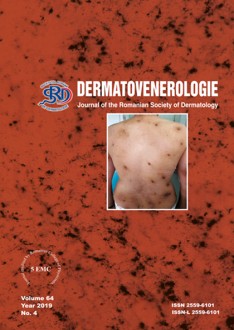Introducere: Prurigo nodular este o dermatoza de
cauza necunoscuta caracterizata prin aparitia de papule si
noduli intens pruriginosi localizati simetric pe fetele
extensoare ale membrelor si uneori pe trunchi. Prurigo
nodular apare in contextul unor afectiuni dermatologice,
sistemice, neurologice sau psihiatrice. Prezentam cazul
unei paciente cu prurigo nodular asociat cu poliendocrinopatie
autoimuna.
Caz clinic: Pacienta in varsta de 43 de ani cunoscuta
cu prurigo nodular de circa 10 ani, cu DZ tip 1 insulinodependent
din 2010 complicat cu boala renala cronica
stadiul III, si boala Basedow-Graves din 2014, se interneaza
in clinica noastra in noiembrie 2017 prezentand astenie
neuromusculara cu agravare progresiva, tulburari gastrointestinale,
cu hiperpigmentare tegumentara progresiva, cu
noduli hiperpigmentati, intens pruriginosi, escoriati,
diseminati simetric pe fata, membre si trunchi. Coroborand
datele clinice si investigatiile paraclinice a fost stabilit
diagnosticul de boala Addison in context de poliendocrinopatie
autoimuna. Examenul histopatologic al unui
nodul cutanat a indicat diagnosticul de prurigo nodular.
Pentru afectiunea cutanata s-a indicat terapie cu dapsona
200 mg/zi, terapie sub care s-a observat disparitia treptata
a nodulilor si a pruritului, rezidual ramanand mici cicatrici
atrofice si acromice.
Discutii: Etiologia prurigoului nodular a fost asociata
cu afectiunile tiroidiene, diabetul zaharat, insuficienta
renala cronica, hepatita colestatica autoimuna, neoplaziile
interne, infectia cu VHC sau cu HIV, si afectiunile
psihiatrice.
Concluzii: Particularitatea cazului prezentat este
asocierea prurigo-ului nodular cu trei afectiuni autoimune
in cadrul unei poliendocrinopatii autoimune: diabet zaharat
tip 1 insulino-dependent, boala Graves si boala Addison.
Cazuri clinice
PRURIGO NODULAR ASOCIAT CU POLIENDOCRINOPATIE AUTOIMUNA


